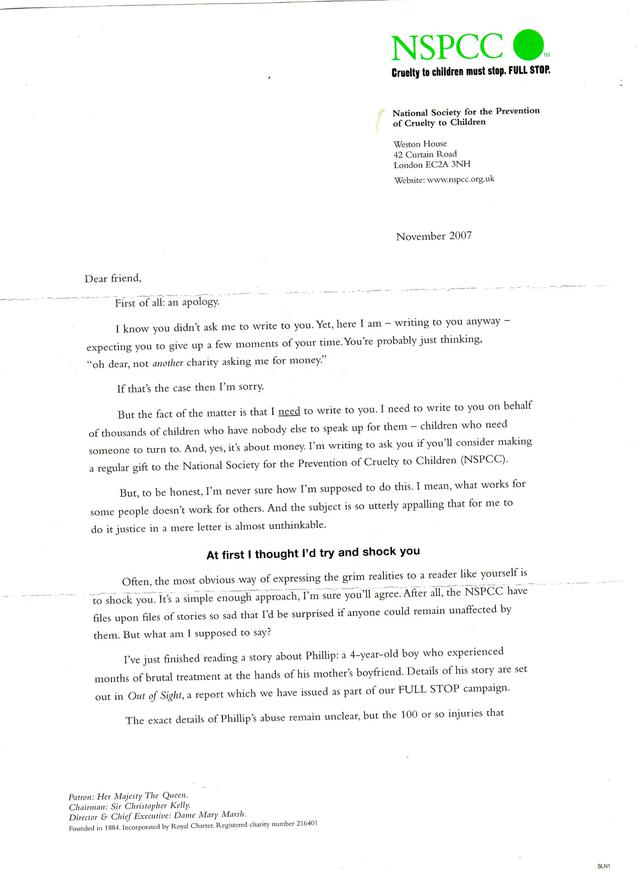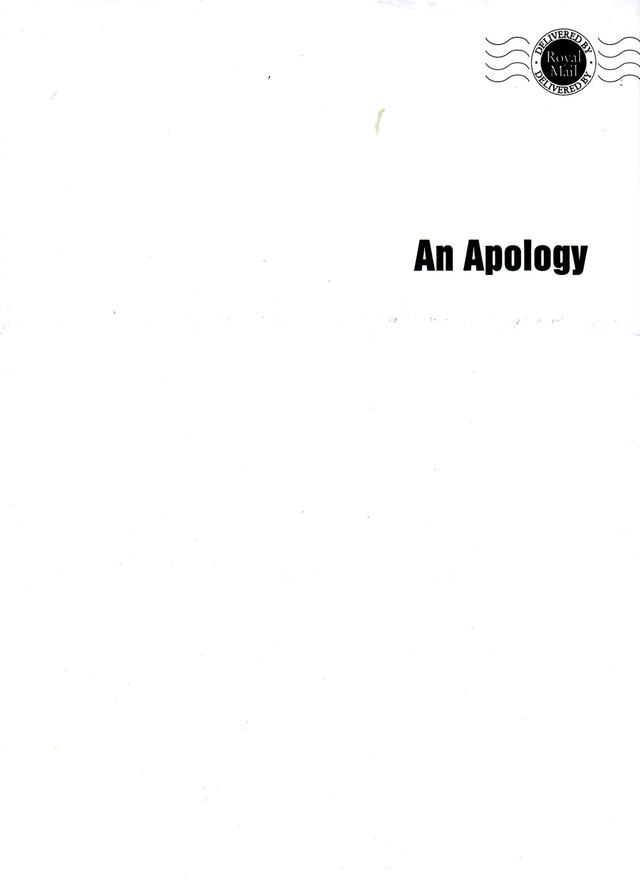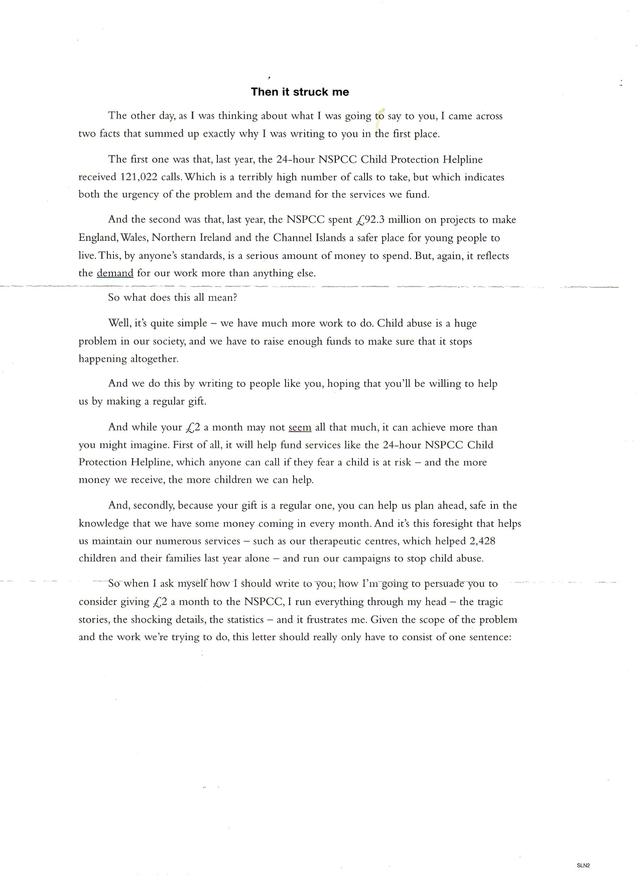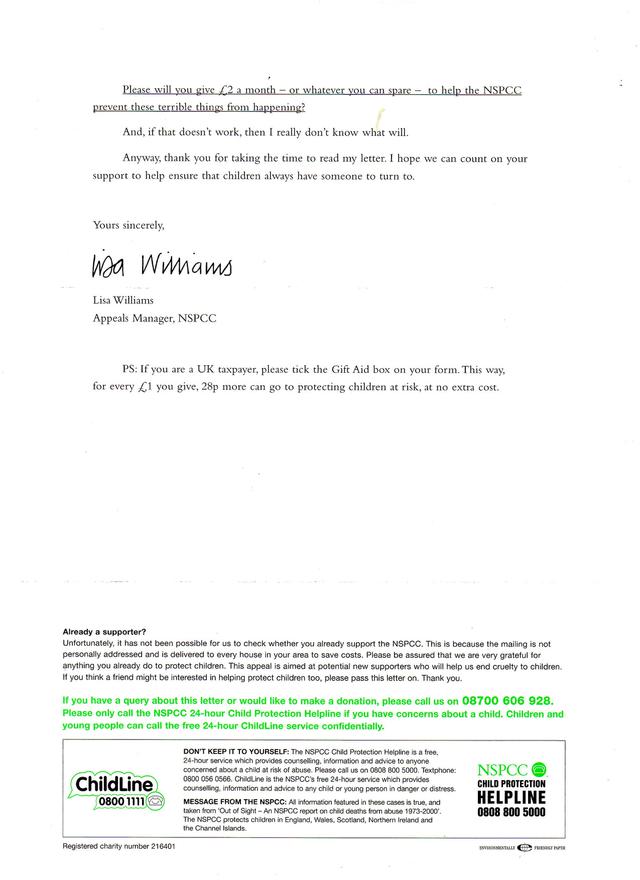How I wrote it: the NSPCC’s Simple pack
- Written by
- Robbie Rae
- Added
- January 05, 2016
Every fundraising copywriter, I’m sure, will have has found him or herself toe-to-toe with an intimidatingly successful control pack at some point in his or her career.
I suspect copywriters who joined the industry at the turn of the millennium, as I did, will be more familiar with this situation than most. After all, the 1990s had seen direct marketing seemingly perfected in all its forms. Decades of testing had led to highly-optimised fundraising packs that seemed to shrug off whatever was put up against them.
At WWAV Rapp Collins in 2002 we had more than a few of these packs doing the rounds. Packs that had been created by true masters of the craft – a skulk of wily old DM foxes whose work consistently out-performed anything created by the new wave of slick brand-strategists or above-the-line refugees. These packs were, in a way, the stuff of DM legend. Oxfam had ‘Dear John’, RSPB had ‘Bird Seed’, and the RSPCA had the imaginatively titled ‘Survey’.
The NSPCC had ‘Alan’.
Alan was an eight-year-old, cold mail control pack that had proved its value time and time again. I would imagine that, by 2002, Alan had recruited tens, if not hundreds of thousands of people to support the NSPCC with £2 a month. As a result, everyone at the agency loved it.
Well, almost everyone.
As a bumptious junior keen to make a mark, I disliked the authority Alan had come to represent. The account team would talk with scientific certainty about why Alan was so invincible. Its success had encouraged dogmatic certainty about ‘what works’ and ‘what doesn’t work.’ A black-and-white (never colour) photo of a two-year-old boy (never a girl) ‘worked’. The pen ‘worked’. The window sticker ‘worked’. More frustrating still was that it seemed that everything that wasn’t the Alan pack didn’t, couldn’t and, worse, wouldn’t work.
It encouraged a creativity-by-numbers approach and that felt counter-intuitive. Green as I was to the industry, I needed to believe that the people could be driven to support a good cause on the back of human conviction and the weight of evidence as much as marketing tricks and techniques.
So it was opportune that one lunch time the account manager, Matthew Hunt, invited me out for a drink. He told me that he needed creative for a second test cell to compete with Alan on ROI and asked if I could think of a way that we could do this.
 View original image
View original image
‘I can write you a letter,’ I told him. ‘Just a letter, mind – no pictures, no pens, with no stickers, no written brief and none of that other stuff your lot always insist on.’
Matthew is an open-minded sort and he showed enthusiasm for the idea – which offered an opportunity for negotiation.
‘Just one condition,” I added, you, or they, don’t get to change a word.’
Matthew shrugged, then agreed, and I set about writing the Simple pack, or An Apology, as it has been variously known.
I suppose, looking back, I wrote An Apology in four parts: first there was the concept, then came the opening, then I crafted the case, then, finally, the call to action – which I have a pretentious urge to call the denouement.
I’ve already touched upon where the first stage, the concept, came from. The idea gestating in me was to persuade a reader to support the NSPCC in spite of marketing – to do so instead out of human decency. (The optimism of youth!)
But I needed a creative way to get this point across. After all, a letter without a leaflet, without imagery, without pens and all the other tricks would simply be a letter as far as the reader was concerned. Direct mail wasn’t central enough to people’s lives for anyone to notice the absence of its usual constituent parts. I had to find a way to demonstrate that these things were deliberately not being included.
The concept (strategy?) I settled on was that the NSPCC shouldn’t need to deploy marketing techniques to make people respond to such a fundamentally simple ask. I would execute this by acknowledging and dismissing these techniques and combine it with a weight of evidence so great that, by comparison, £2 a month would seem like the easiest thing in the world to give. I wanted conviction to overcome convention.
Once I’d settled on the approach, I began to write. And the first and most interesting challenge in any fundraising letter is to craft an intriguing and direct opening.
This particular fundraising letter starts with an apology (of sorts). That’s because the first marketing convention I wanted to challenge was the very act of mailing people and asking them for money. But it’s quite hard to challenge something’s very essence – so I thought it best to apologise for the inconvenience and explain why we’d taken a liberty with their time and their privacy. This allowed me to get the initial ask up nice and early. The version I’m looking at now – and which I’ve included with this piece – has been amended by subsequent generations of client. The original said,
‘First of all: an apology.
I know you didn’t ask me to write to you. Yet, here I am – writing to you anyway – expecting you to hang on my every word. You’re probably just thinking, “Oh dear, not another charity asking me for money.”If that’s the case then I’m sorry.’
This apology, however, does not hang in the air for long. It is retracted almost immediately in the sentences that follow. I wanted the reader to understand, right from the outset, that we weren’t pestering them out of mere philanthropic whim, but because we had no option but to write to them. I wanted to stress that our conviction (there’s that word again) for protecting children from abuse made it impossible to leave any fundraising stone unturned. We simply had to ask.
It was a case of ‘sorry, but not sorry’.
This set up the platform for the third section: the case for support. Here, the style of writing is as much about the signatory as it is about the content. I write this in character. I write as a client, not as a copywriter. I write as someone who doesn’t really know how to ask for money. I write as someone who perhaps has 15 mail packs open on the desk in front of her and is keen to copy some of the techniques these professionally created packs use. Yet in doing so, she finds each technique utterly futile as a means to express her conviction for the cause.
Why should she have to try so hard?
She looks at the shock tactics that charities use, before concluding that, in this case, such tactics are completely unnecessary as the bare facts are shocking enough. She then considers deploying statistics to make her case as she has these at her disposal too. But, again, she feels frustrated at any kind of quantitative argument, insisting instead that it’s the qualitative effects of child abuse that should move us.
Now, to the knowing mind, this is all horribly insincere. It’s quite clear that we are deploying exactly what we know works while at the same time dismissing it. But for an audience who weren’t so familiar with the industry of DM this clearly struck a chord. To them a signatory came across as a human being with the same shortcomings as anyone else. They were reading a letter from someone trying to do her job and feeling somewhat at a loss.
The signatory then cements the case for support with two stark facts. First, that the NSPCC’s services are in high demand and, second, that we simply can’t afford to meet that demand. And given the cause we are talking about – the horrors of which we have established indirectly earlier on – this should be reason enough for someone to give £2 a month.
The case for support is concluded with an explanation showing what this sum of money can achieve and why it’s important to the NSPCC from a logistical point of view. There’s a current dogma that people give to the causes not the organisation. I would disagree. Nothing in our sector is that binary. People give to the cause and the organisation.
Okay. So (deep breath), the fourth part – the call to action. In this case it surmises everything that has gone before and distils everything down to one simple idea. In fact, it’s barely a call to action at all. I didn’t even include instructions on how to donate as I felt the signatory was too emotionally exhausted from writing to conclude with such a formality. She just lets the reader work it out for herself.
I will just include the copy verbatim here, as it’s clear enough to need no explanation:
‘So when I ask myself how I should write to you; how I’m going to persuade you to give this elusive £2 a month to the NSPCC, I run everything through my head – the tragic stories, the shocking details, the statistics – and it frustrates me. Given the scope of the problem and the work we’re trying to do, this letter should really only have to consist of one sentence:
Please will you give £2 a month – or whatever you can spare – to help the NSPCC prevent these terrible things from happening?
And if that doesn’t work, then I really don’t know what will.’
 View original image
View original image
And that was that. The letter was a huge success, beating the eight-year-control and acting as the NSPCC’s cold control pack for a many years afterwards (I’m tempted to say seven, but I can’t verify that). It was later rolled out as a door drop and proved just as successful, thanks in part to my creative director, Nick Platt, adding the headline An Apology to the outer envelope.
So in conclusion to how I wrote this pack, I would say there are three key things to bear in mind. First, I wanted to offset the weight of evidence for giving against the amount we were actually asking the reader to give, an approach I believe in to this day. In this case, we had the absolute horror of child abuse, painstakingly detailed in a recent NSPCC white paper – compared to the relatively paltry sum of £2 a month. I wanted to balance the two in the reader’s mind so they would get to the point where they said, ‘Well, of course, I’ll give that! Who on earth wouldn’t?’
Secondly, I wanted to use the voice of the signatory over the brand. I know how important tone of voice is and it has been wildly successful for charities such as Macmillan but, again, it isn’t a rule for everyone. A human signatory can, on occasion, serve as a useful veto to brand hegemony. Conviction can trump convention and so it was here. This letter is written, ostensibly, by a well-meaning, marketing naïve who just wants to raise money for the cause she believes in so deeply. She needs the reader to meet her half way and to care as much as she does. People like someone who tries and I wanted the reader to share the signatory’s passion and buy into that as much as the cause.
Thirdly, it was about the conviction of this signatory. I’m sure all copywriters are familiar with the old American AIDA – attention, interest, desire, action – principle. Well, in his dusty industry tome, Successful Creativity in Direct Marketing (Institute of Direct Marketing, UK, 1998), John Watson (founder of WWAV) added a C to this famous sales mnemonic. He wrote of AIDCA – attention, interest, desire, conviction, action. I agree with Mr. Watson. This C word that can so often be the magic ingredient in successful fundraising copy. (It is worth noting that others have made additions to AIDA. George Smith in Asking Properly [White Lion Press Limited, UK, 1996] added C for conviction and P - for proof.)
But perhaps most opportune of all was how this pack came about in the first place. Circumstances and favourable personnel played a vital role in helping the pack win the day. A brave account manager was at a bit of a loss for a test cell and was willing to take a punt on something different. While our clients, Elvira Lyons, Lisa Williams and Tim Hunter, were willing to let it run as it was written.
When the results finally came through, and we’d found out that the pack had dethroned Alan, it felt like we were underdogs who had just won the World Cup. Matthew and I ended the creative journey exactly as it had begun: with a well-earned pint by the river.



















